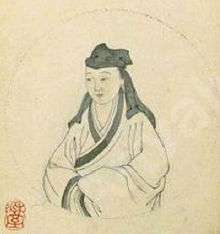Liu Rushi
| Liu Rushi | |
|---|---|
 1847 portrait of Liu Rushi, ink on paper, by Lu Ji and Cheng Tinglu | |
| Born |
Yang Yunjuan[1] 1618 Jiaxing, Zhejiang |
| Died | 1664 |
| Resting place | Mount Yu, Changshu, Jiangsu |
| Nationality | Chinese |
| Other names | Liu Shi, Liu Yin, Yang Yin, Yang Yinglian, Yang Ai, Hedong |
| Occupation | Courtesan and poet |
| Known for | Poetry, marriage to Qian Qianyi |
Liu Rushi (Chinese: 柳如是; pinyin: Liú Rúshì; Wade–Giles: Liu Ju-shih; 1618–1664), also known as Liu Shi, Liu Yin and Yang Yin, was a Chinese courtesan and poet in the late Ming dynasty who married Qian Qianyi at the age of 25. She committed suicide on the death of her husband. She famously exchanged verses with Chen Zilong, and was noted for her painting.[2]
She was friends with fellow courtesan Chen Yuanyuan, who was the concubine of Wu Sangui.[1]
She is one of the Eight Beauties of Qinhuai (Chinese: 秦淮八艳) described by late Qing officials. The other famed courtesans of this group are Ma Xianglan, Bian Yujing (卞玉京), Li Xiangjun, Dong Xiaowan, Gu Mei, Kou Baimen (寇白門), and Chen Yuanyuan.[3]
Early life
Believed to have been born in Jiaxing, Liu was sold by her family as a concubine to the Prime Minister Zhou Daodeng.[4] At the age of thirteen, a scandal led to her expulsion from Zhou's household, and she was sold to a brothel in Suzhou.[1] At seventeen, she had her first major love affair, with the painter Tang Shuda.[5] Already a noted poet and painter herself at this early age, she met Chen Zilong in 1635 and lived with him for about a year, eventually leaving after his family disapproved of their liaison. After leaving Chen, she managed a brothel in Wujiang.[1][4][6] An affair with the artist Wang Janming ended when Wang failed to attend an appointment with her at the Rainbow Pavilion. Another affair with Song Yuanwen, a government official, ended when his vacillations over marriage resulted in Liu smashing her lute and storming off in a fit of pique.[5]
Marriage to Qian Qianyi
In 1640 Liu embarked on a campaign to marry the respected scholar Qian Qianyi. Dressed in men's clothing, she accosted Qian and requested his opinion on one of her poems.[5][6] Qian apparently believed her to be a man, but later in the year he had established her at a specially built hermitage in the grounds of his Suzhou estate, called the "According to Sutra Studio". They married in 1641, whilst on a river cruise; Qian bestowing upon his bride the new name of Hedong.[1][5] Although he married her as a concubine, Qian treated Liu as his principal wife, and they were married in a formal wedding ceremony.[4][6] Her affinity for cross-dressing persisted after they were married; she regularly wore men's clothing whilst in public and on occasion made calls on her husband's behalf whilst dressed in his Confucian robes (this affectation earned her the nickname rushi, "Confucian Gentleman", which also puns on her chosen name Rushi).[1]
After the collapse of the Ming Dynasty in 1644, Liu tried to persuade her husband to commit suicide and martyr himself to the fallen Ming. Qian refused, instead choosing to organise the resistance movement against the newly established Qing regime. In 1648, the couple had a daughter together.[2][6]
The last years of her life were difficult for Liu. In 1663, she entered the Buddhist laity, partly as a response to the destruction of her husband's substantial personal library, the Crimson Cloud-Storied Hall.[6] After Qian's death in 1664, his creditors and enemies attempted to extort money from Liu; their machinations eventually drove her to hang herself.[2][6]
Poetry
During her life Liu was a prolific poet, publishing four collections of her work before the age of 22.[2] Her calligraphy was noted for its bold, masculine strokes,[1] using the "wild-grass script" style.[6] Her solo anthologies included Songs from the Mandarin Duck Chamber and Poems Drafted by a Lake, and her poetry was published alongside her husband's in a number of his works.[5][6]
See also
References
- 1 2 3 4 5 6 7 Dorothy Ko (1994). Teachers of the Inner Chambers: Women and Culture in Seventeenth-Century China. Stanford University Press. pp. 273–7. ISBN 978-0-8047-2359-6.
- 1 2 3 4 Marsha Smith Weidner (January 1990). Flowering in the Shadows: Women in the History of Chinese and Japanese Painting. University of Hawaii Press. pp. 84–105. ISBN 978-0-8248-1149-5.
- ↑
- Xie 谢, Yongfang 永芳; Shi 施, Qin 琴 (2014). "像传题咏与经典重构———以《秦淮八艳图咏》为中心" [Acclaim for portraits and classical reconstruction: 'Qinhuai bayan tuyong' as the centre]. Zhongguo Wenhua Yanjiu (2): 180–188.
- 1 2 3 Melissa Hope Ditmore (1 January 2006). Encyclopedia of prostitution and sex work: A-N. Vol. 1. Greenwood Publishing Group. p. 255. ISBN 978-0-313-32969-2.
- 1 2 3 4 5 Victoria Baldwin Cass (1 January 1999). Dangerous Women: Warriors, Grannies, and Geishas of the Ming. Rowman & Littlefield. pp. 40–44. ISBN 978-0-8476-9395-5.
- 1 2 3 4 5 6 7 8 Bonnie G. Smith (2008). The Oxford Encyclopedia of Women in World History: 4 Volume Set. Oxford University Press. pp. 125–6. ISBN 978-0-19-514890-9.